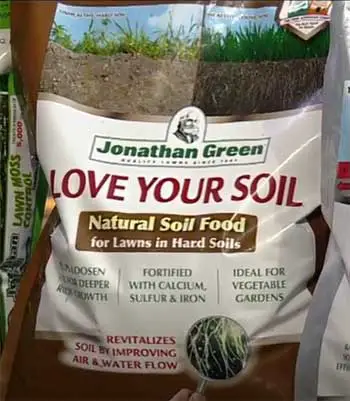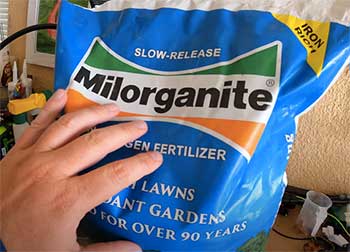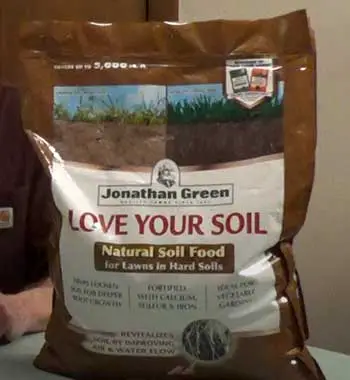A good quality fertilizer is necessary to ensure healthy growth and a natural greenish appearance for lawns. Since ample options are available, choosing the best one might be tricky.
That’s why we have decided to go for a review session on Love Your Soil and Milorganite Fertilizer.
The Jonathan Green Fertilizer has a special formula that is Rich in humates, and it is perfect for hard and compacted soil. And the Milorganite Fertilizer contains a slow-release nitrogen formula, ideal for sandy soils.
Let’s learn more about these two fertilizers.
A Quick Comparison Table
Before learning full details about each fertilizer, how about having a quick overview of them? Check out this comparison table to get brief yet important information about them.
| Specifications | Jonathan Green Fertilizer | Milorganite Fertilizer |
| Formula | Rich in humates | Slow-release nitrogen formula |
| Quantity options | Three options | Only one option |
| Ideal usage | Hard and compacted soil | Sandy soils |
| Nutrition lastingness | Up to 12-14 weeks | Up to 10 weeks |
| Where to use | lawns, trees, shrubs, and flowers | Turfgrass, vegetables, and fruits |
| Price | Higher | A slightly lower |
In-depth Differences Between Love Your Soil And Milorganite Fertilizer
Is it enough to make an informed purchasing decision after learning a brief overview? We don’t think so! That’s why we recommend you go through the complete details about both fertilizers.
- Different Formula

Before choosing a particular fertilizer, it is crucial to know its formula type.
The Jonathan Green Fertilizer has a special formula that is rich in humates.
The product can provide up to 5% organic humus to the lawns that have less than 1%.
This will make the soil healthy and biologically active.
On the other hand, the Milorganite Fertilizer contains slow-release nitrogen formula.
It is a safer option since the release of nitrogen occurs slowly. It continues for several weeks.
In this regard, Milorganite works differently than HumiChar as well!
The lawn won’t have any burning issues. After all, no overdose of fertilization occurs. It won’t be too strong to bear. The grass can tolerate it comfortably.
- Quantity Options
Our lawn size varies. So, we don’t need the same quantity of fertilizers. Larger gardens need a massive amount of fertilizers.
The Jonathan Green Fertilizer comes in three options: 3.6 pounds, 19 pounds, and 55 pounds. You can choose any option based on your garden size.
On the contrary, only one option is available for Milorganite Fertilizer. However, the 36 pounds is perfect for any medium or large-sized lawn. It is an economical choice too.
- Ideal Usage
Not all soils are perfect for using a particular fertilizer. You must figure out whether the specific one is ideal for your garden soil.
The Jonathan Green Fertilizer is ideal for hard and compact soil. It can effectively and gradually release enough nutrition to make the grass healthy and green.
Also, grass growth will boost. And its roots will develop efficiently. Loosen heavy and packed soils will transform into healthy and nutrients rich soil.
Contrastly, Milorganite Fertilizer is suitable for sandy soils. It can release nutrients for an extended time. Loosening up and aerating the soil is what this fertilizer does.
Moreover, this high-quality plant food can retain phosphates, potash, nitrogen, and calcium for a reasonable time. But regular fertilization is essential to ensure healthy soil.
- Nutrition Lastingness

How long can the nutrition of fertilizer last? It is an important aspect to consider.
The longer it stays, the less frequently you need to apply it.
The Jonathan Green Fertilizer can last up to 12 to 14 weeks. This means you can keep yourself worry-free for about 3-4 months.
On the other hand, the nutrition of Milorganite Fertilizer can stay on the soil for a maximum of 10 weeks. It releases the essential nutrients slowly.
This special product prevents burning your beautiful lawn. Also, it ensures sustained grass growth. Hence, you will have to go for fewer mowing sessions. It will cut down your mowing time.
- Where To Use
Apart from the soil, you need to know which plants and grass areas are ideal for using a particular fertilizer. Applying plant food on the wrong plant or grass won’t positively impact.
Generally, you can use Jonathan Green Fertilizer on lawns, trees, shrubs, and flowers. It is entirely safe. You won’t experience any unwanted issues.
Contrastly, Milorganite Fertilizer is perfect for use on turfgrass, vegetables, and fruits. The turfgrass will start to become greener. Also, you will see how beautiful the flowers are blooming.
Besides tomatoes, cucumbers, strawberries, etc., everything will bring their fruits on time. Its ideal amount of potassium can bring the best lawn on the street.
- Price
How much are you ready to pay to buy a bag of fertilizer? Some people buy a large quantity to save a few bucks. However, correctly storing them is crucial too.
Compared to Milorganite Fertilizer, Jonathan Green Fertilizer has a slightly higher price tag. But it is worth the price you spend. The plant food can retain nutrition in the soil for a long time.
Pros of Love Your Soil

- Balanced NPK ratio. With an NPK of 2-5-3, Love Your Soil provides a balanced feeding for robust root development, sturdy stems, and lush foliage. The lower nitrogen encourages steady, even growth rather than a rapid growth spurt.
- Unique mix of organic ingredients. The combination of feather meal, alfalfa meal, kelp meal, and humic acid provides a diversity of nutrients to feed soil microbes and strengthen plants.
- Builds soil health. By feeding soil microbes and adding organic matter, Love Your Soil enhances soil health over time for stronger grass plants.
- Safe for people, pets, and the planet. Contains zero synthetic chemicals, meaning no burn risk if over-applied. Gentle enough to use around children and pets.
Cons of Love Your Soil
- Lower nitrogen. With just 2% nitrogen, Love Your Soil may not produce the quick greening effect that some desire. Need to apply more product to get the same nitrogen as higher N options.
- Contains feather meal. Some find the idea of using feather meal off-putting, even though it’s highly effective as a natural slow-release nitrogen source.
- More expensive. As a premium organic fertilizer, Love Your Soil costs more per bag than budget options.
- Only comes in large bags. The 40 lb bag is heavy and bulky, making storage and handling difficult. No small bag options currently available.
Overall, Love Your Soil is a quality organic fertilizer ideal for those seeking a natural, soil-building approach for lush grass. It’s a great option for greening up lawns in early spring and fall without excess growth.
Pros of Milorganite
- Budget-friendly price. As one of the most affordable organic fertilizers, Milorganite is attractive for cost-conscious homeowners.
- Slow, steady feeding. The nitrogen in Milorganite is released slowly over 2-3 months, resulting in steady greening without surge growth.
- Low burn risk. With its low salt index, Milorganite can be applied heavily without risk of burning grass.
- No mixing required. Comes ready to apply – no messy mixing or dissolving needed.
- Trusted reputation. Used by homeowners and professionals for decades with proven results.
Cons of Milorganite
- Limited nutrients. Provides only nitrogen with no phosphorus or potassium. Must supplement with other fertilizers to get a complete feeding.
- Strong odor. The recycled biosolid composition causes an unpleasant smell during application that lingers temporarily.
- Contains biosolids. Some individuals prefer to avoid anything containing treated human waste, despite safety assurances.
- Clumps when wet. Milorganite can clump together when stored in humid conditions, making application difficult.
- Lower quality. In recent years, some question whether production changes have led to reduced quality and performance compared to Milorganite’s heyday.
While Milorganite is an affordable organic option, the single-nutrient composition and biosolid source may be deal breakers for some homeowners.
Which Fertilizer Is The Best For Your Lawn?

Here comes the trickiest part to answer. Fertilizers are made with various ingredients. Manufacturers follow different methods to process them.
Choosing a particular fertilizer requires you first to decide your lawn type, soil type, and the available plants in the garden.
If your garden has hard and compacted soil and the soil has a lower amount of humates, Jonathan Green Fertilizer is an ideal option. It can show reliable results within a short time.
On the other hand, Milorganite fertilizer is a perfect pick when your backyard has sandy soils. It can provide impressive change for your turfgrass, vegetables, and fruits.
Frequently Asked Questions (FAQs)
Safer Brand, Andersons, Simple Lawn Solutions, Scotts, Espoma, etc., are a few best alternatives for Milorganite. These brands are a reliable option for growing a healthy-looking lawn.
Milorganite does not contain any human feces. Usually, the manufacturer uses composed of heat-dried microbes, known as organic compounds, to make this fertilizer.
Generally, most flowers and vegetables are safe for using Milorganite. After all, it is a safe and slow-release fertilizer. It won’t cause any burning issues. You just need to follow the manufacturer’s instructions properly.
Milorganite fertilizers are made of more than 80% of organic compounds to ensure proper nutrition for the plants. You can use it for any clay or sandy soil. It can improve the growing ability of soil gradually.
Yes, you can use an excessive amount of Milorganite on the soil. Unlike other fertilizers, it won’t cause any burning problems or other issues. After all, the product has slow-release nitrogen formula.
Milorganite will green up your lawn thanks to the slow-release nitrogen it provides. It may take a bit longer to see greening compared to synthetic fertilizers, but the results are natural and long-lasting. To get the best greening effect, apply Milorganite at the start of the growing season in early spring. Reapply every 6-8 weeks as needed to maintain the color.
Wrapping Up
So, what you have finally decided after going through a comparison session on Love Your Soil and Milorganite Fertilizer?
Choosing either option won’t be wrong since they are no less. Each fertilizer is appropriately tested to ensure no harm to the soil and lawn.
You just need to know your lawn and soil type. Then, buy the suitable option to get the best result. Ensure to follow the manufacturer’s direction precisely to apply the fertilizer at the right quantity and time.

Milorganite is sewage sludge, it contains heavy metals, industrial waste, forever chemicals and a host of other things you would not want in your lawn and soil or near your children, pets or family.